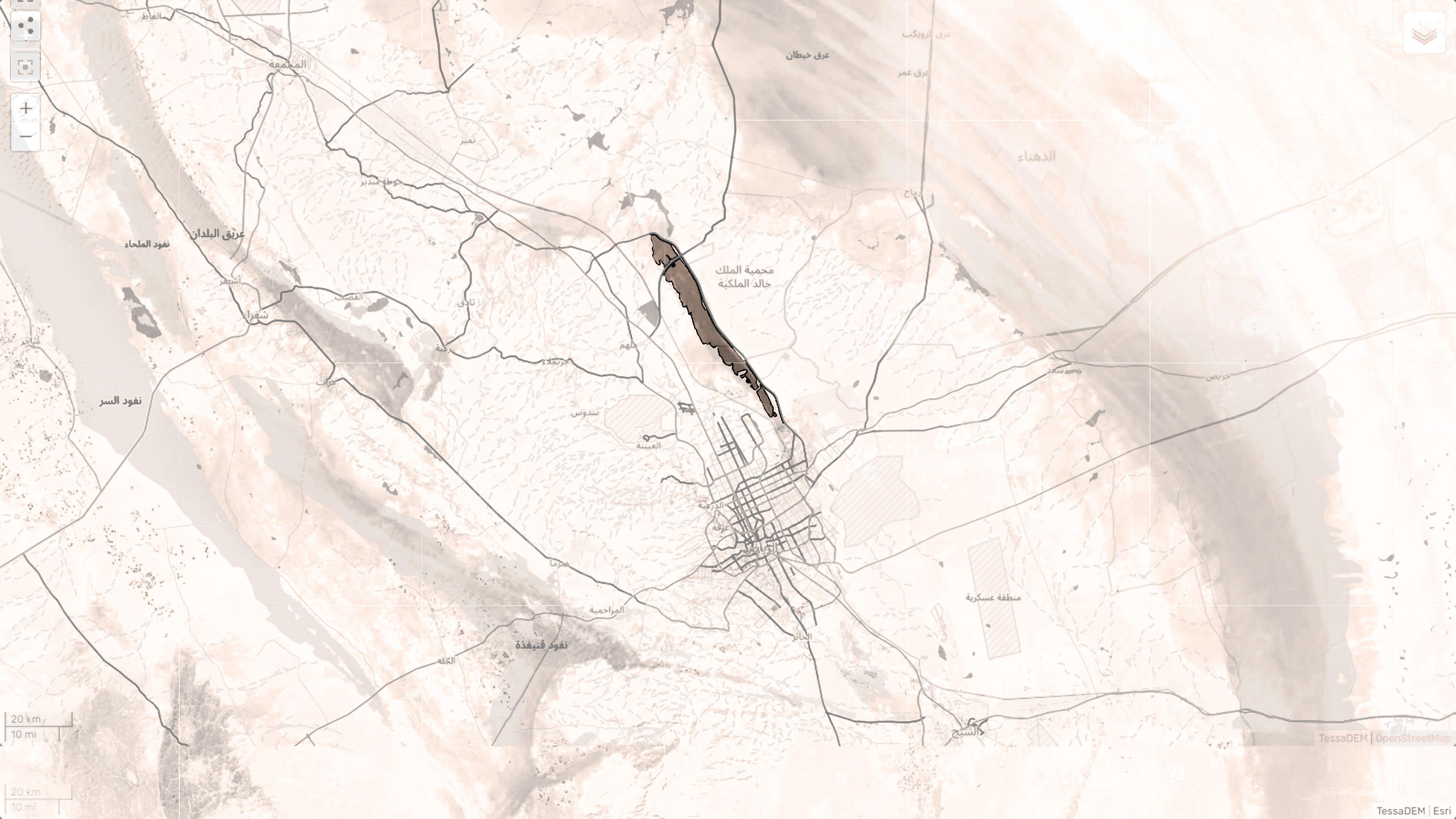MIGRATING SANDSCAPES
From The Microparticle To The Architecture LAMIA

ALBUNNI
The migration of dunes is a widespread phenomenon. Hundreds of years ago, the nomadic tribes adopted their transient character due to the shifting landscape. Many ancient cultures have settled and evolved into major urban centers from the heart of the Arabian Desert. Modern cities in desert regions are battling the restless dune sand that advances into their urbanized territories. The current architectural response to this harsh environment raises many ecological and economic concerns. Cities like Riyadh, Dubai, and Doha are surrounded by dunes of sand, yet they do not use local sand as a resource. Instead, river sand is imported from other countries because it is deemed more feasible for the industry. The significance of the desert is evident in its rich resources and poetic cultures; thus, it is crucial to consider the usage of the abundant resources, rethink the current architectural position and educate the next generations. In this study, the literature review touches upon the poetry of the desert and refers to theories and philosophies of the sublime. This research examines the overall architectural progression of Riyadh in Saudi Arabia, takes a scientific experiment that tests desert sand as a primary ingredient for modern construction material and uses it to design regional architecture for a productive desert community. The desert philosophical theories and the scientific material studies set the basis for an architectural scenario of transiency, temporality, and growth. The selected site, Al Thumamah, acts as a gateway to the existing city, and the scale of the site opens a territorial dialogue between the permanent city of Riyadh and the ephemeral qualities of the desert. This thesis aims to set a vision for the desert city of tomorrow that seeks to employ regional material with traditional construction methods to reconnect the locals with their culture and natural resources.
I Introduction
II Sand As A Resource
III Situation & Setting
IV Sand Formations
V Territorial Formations
VI Architectural Formations
VII Material Study Catalog
I Introduction
The migration of dunes is caused by the constant movement of air. Wind forms massive piles of sand called dunes that, according to National Geographic, can rise as high as 590 feet. It is estimated that dunes shift a few yards per year, but in the event of a severe sandstorm, dunes can move 65 feet in a single day. The advancement of dunes toward the inhabited regions of the deserts is an ongoing phenomenon. Modern cities in the Arabian Desert are set in close proximity to the piling dunes, which raises the question of the abundance of resources and construction methods. Finding the balance and integrating the existence of desert and architecture is crucial to maintain a long-term sustainable solution.
 Husain. The Half-Desert Road in Dubai, United Arab Emirates. November 5, 2019. Instagram.
Husain. The Half-Desert Road in Dubai, United Arab Emirates. November 5, 2019. Instagram.
This research examines the extent of the Kingdom of Saudi Arabia, which occupies about 70 % of the Arabian Peninsula on the southeast edge and includes most of the Empty Quarter desert. Saudi Arabia has evolved rapidly from nomads in the early 1700s to tribal settlements in the 1800s to modern cities in the twenty-first century. This drastic growth was the discovery of oil, quickly turning the construction industry from mainly local building materials to greater reliance on imported materials. Capitalism, tourism, and the drastic population growth were the primary factors in developing steel and concrete high-rise structures. Most of these structures require sand that is different from desert sand as an ingredient for concrete and other manufacturing purposes. River sand is imported from Asia and Australia to meet the demanding development projects. Thus, the development does not comply with the natural resources and environmental conditions. According to Farr, “the carbon footprint and overall sustainability factor for every building in the region increases.” Sand is one of the earth’s most consumed natural resources, besides air and water. Consequently, there are substantial environmental impacts from the extensive river sand mining, resulting in the destruction of the local ecosystems and the mining regions hundreds of miles away which supply these projects. The United Nations projects that in 2060, sand and small aggregate will continue to be in high demand due to the extensive use of concrete.
1

Saudi Arabia Red Sea
Kuwait
Riyadh
Arabia
Persian Gulf
Qatar
Empty Quarter
Yemen
United Arab Emirates
Gulf of Oman
Oman

2
THE ARABIAN PENINSULA

Bedouin Tribes
Qasr Al Murabba
king
stadium
Qasr Al Masmak
fahd
Justice Palace
Riyadh
Water Tower monetary agency head office
1700 100AD 1865 1986 1745 1930 1970 1978 1987
At-turaif Palace

king fahd stadium king khaled iairport
Financial District
monetary agency head office
khayriyya complex
Riyadh Telecom Tower
Riyadh Water Tower
DISCOVERY OF OIL 1983 1989 NOW... 1982 1981 1987 2003 2000 SAUDI ARABIA ARCHITECTURAL TIME-LINE 3
Al Faisaliah Tower Kingdom Center Majdoul Tower

One- fifth of the earth is covered by desert, and desert sand covers most of the Arabian Peninsula. Yet this sand, in its abundance, remains unused in this region. Dune sand consists of round particles shaped by the wind, making it a finely-grained material that is harder to bind than river sand. In addition, it is more angular because it is shaped by water and has a high concentration of silica; therefore, trying to make it structurally stable is challenging. The necessity of employing desert sand and investigating the use of the material as a substitute for river sand, especially in desert regions, is a critical environmental concern. This thesis examines the dune sand as a design medium and understands its physical characteristics and reactions with the solidification substance. The material investigation consists of three stages:
• Distribution: Based on sand formation theories and observations.
• Solidification: Using a Saline solution through the crystallization process.
• Dissolution: Material life cycle.
4


III Situation & Setting

Saudi Arabia Riyadh


6
ZONE 4
ZONE 3
ZONE 2

RESEARCH CAMPUS
ZONE

1 7


8








SITE FEATURES & ECOLOGY 9


Playas
dry lake beds, ephemeral
Salina: playas with high salt content
Basin-and-Range Terrain

Range long, narrow and parallel Basin broad, flat internal region between ranges Interior drainage, no connection to the sea

11
HYDROGEOLOGY
SALT FLATS = WATER = DEPRESSIONS


DEPRESSIONS = SETTLEMENTS


12
V Territorial Formations

Based on the previous examination of the sand formations, synonymous terminologies uncover a logical territorial approach for organizing the main campus, operation hubs, and dwellings. The new establishment traces the underground water lines and depressions where salt flats emerge. Site analysis and documentation aid in understanding the behavior of the local community. The illustration on the right shows the most recent camp area along the main road with 8,500 acres. The center illustration extends the street settlement divisions and reveals a dynamic grid that gets denser at the northern and southern tails of the strip. This resembles a nomadic approach to addressing safety and controlling the territory. Finally, the diagram on the left represents the elevations once again to expand upon the idea of settlers favoring being encompassed by the landscape to be protected from heat and wind at the lower depressions of the basin.
The proposed social scenario is obtained from establishing the relation network between the three dominant users to nourish the region’s productivity. The Bedouin offers local expertise, land ownership, and hospitality. In return, the researcher provides scientific experimentation of the available resource and building methodologies, fostering the connection between the locals and explorers with the Bedouin culture and heritage. Finally, the explorer comes to learn, retreat and worship and leaves with stories to tell the world. In the end, each participant shakes hands with one another in building a productive, self-sustained community.


RESEARCHER Advanced Science Natural Resources Productive Communities BEDOUIN Local Expertise Land Ownership Case Studies EXPLORER Learn Retreat Worship


This site is the main campus because it has the highest salt concentration and happens to be at the center of Al-Thumamah Strip. The campus consists of research pods clustered around the larger expansion of salt flats. Northeast of the site is the major approach to the site from Al Janadriyah main road. Driving to the arrival center takes about three minutes, where the user typically leaves the car and continues the journey on foot. Additional accessibility routes from the northwest and the southwest connect the site to adjacent sites, about a ten-minute drive. The grey pods represent the program; these are existing territories locals offer to facilitate the research. The research campus has eight unique program categories offering various activities, from the more public activities in the science, trade center, and educational facility to the more user-specific facilities such as the logistics hub, chemical lab, production and research facilities, and design studios all in which require expertise in the scientific field of building and material development.
RESEARCH CAMPUS
14

SCENARIO: TIME-FRAME
Sand Shell Structures Life-Cycle
PROTO-SCENARIO
From the central zone of the larger scale territory, four selected zones act as research satellites spread out along the strip, as illustrated in the territorial formation proposal, Figure 28. Each zone would serve as an operation hub to serve the surrounding case-study units.
The proposed time frame is dominated by the main idea of the material experiment, where it is distributed, solidified, and crystallized until it dissolves by the weather conditions. The sand structures follow a seasonal life cycle that starts with the fabrication and assembly end of December with the end of the possible precipitation season. The construction period extends up until early February. The projected end of the life cycle is by the end of August.
Material Production Consumption DISTRIBUTION SOLIDIFICATION DISSOLUTION November August December September January October February May March June April July 15


VI Architectural Formations
Bedouin tents, also known as “bait al-sha’ar,” is an architectural adaptation responsive to the arid regions of the Arabian deserts. It is designed to provide shelter from harsh climatic conditions while also accommodating the nomadic lifestyle of the Bedouin people. The tent is typically made from woven goat-hair fabric, which is lightweight, durable, and provides effective insulation against the extreme heat and cold of the desert. The concept of seeking shelter in this indigenous structure is compelling. It evokes the idea of thickening the ground and occupying the poche. This idea will be the theme of generating the sand shell structure on site. Another fascinating concept is that those Bedouin tents camouflage with the dunes and blend appropriately with their surroundings as means of protection. Likewise, the sand shell structures are intended to submerge within the dunes and adapt to the environment.

SYSTEMS & TECTONICS
The systems and tectonics of the proposed structure are defined as a semi-permanent kinetic skeleton that is simulated to adapt and respond to the shifting sand dunes. The design comprises a skeleton frame that sensitively moves as the dunes shift and change while being self-supported at all times. This skeleton is then covered with a sand shell skin structure designed to dissolve and wear off seasonally, allowing new skin to be fitted seamlessly onto the existing frame. This innovative design allows maximum flexibility and adaptability to the harsh desert environment, ensuring that the structure can withstand the forces of nature while providing a shaded, protected space beneath the system.



18
Beginning of Season
YEAR YEAR 1
Dune Movement Tectonic Adaptation
DECEMBER 2023
Dune Movement Tectonic Adaptation
MAY
 Skeleton
Skeleton with
Skeleton
Skeleton with
YEAR 2
Movement Adaptation
End of Season
YEAR 3
Dune Movement
Tectonic Adaptation with Skin

SEPTEMBER 2024
Skeleton Adapts to New Dune Form
Skin Erodes
PHASING
MAY 2024
19




PLAN & SECTION 20



21
VII Material Study Catalog




























































22


23



 Husain. The Half-Desert Road in Dubai, United Arab Emirates. November 5, 2019. Instagram.
Husain. The Half-Desert Road in Dubai, United Arab Emirates. November 5, 2019. Instagram.



































 Skeleton
Skeleton with
Skeleton
Skeleton with





































































